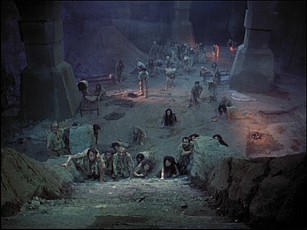On January 3, 1978, during what must have been my first visit back to London after moving from there to San Diego in early 1977, I attended a private screening at the British Film Institute of glorious new prints of Fritz Lang’s Indian films. Over four years later, when I was invited to program “Buried Treasures” at the Toronto Festival of Festivals, I was delighted to be able to book these prints and thus hold what I believe was the North American premiere of Fritz Lang’s penultimate films in their correct versions, uncut and subtitled in English rather than dubbed. Luckily, Film Forum’s Karen Cooper attended this screening, and two years later, when she booked these prints for a theatrical run, she commissioned me to write program notes, reprinted below. — J.R.  THE TIGER OF ESCHNAPUR/THE INDIAN TOMB
THE TIGER OF ESCHNAPUR/THE INDIAN TOMB 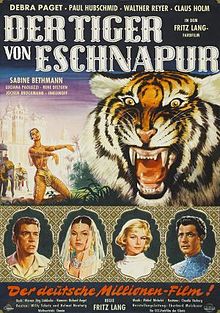 (1958, 1959/101, 97 min.) Directed by Fritz Lang. Exec. Producer: Arthur Brauner. Screenplay by Lang & Werner Jorg Luddecke from a novel by Thea von Harbou & a scenario by Lang & von Harbou. Photographed by Richard Angst. Art direction by Helmut Nentwig, Willy Schatz. With: Debra Paget (Seetha), Paul Hubschmid (Harald Berger), Walter Reyer (Chandra), Claus Holm (Dr. Rhode), Sabine Bethmann (Irene Rhode), René Deltman (Ramigani). West German. German with Eng. subtitles. Distributor: British Film Institute. September 14-27, 1983 Mon-Fri: 4:50, 8:30 / Sat-Sun: 1:10, 4:50, 8:30
(1958, 1959/101, 97 min.) Directed by Fritz Lang. Exec. Producer: Arthur Brauner. Screenplay by Lang & Werner Jorg Luddecke from a novel by Thea von Harbou & a scenario by Lang & von Harbou. Photographed by Richard Angst. Art direction by Helmut Nentwig, Willy Schatz. With: Debra Paget (Seetha), Paul Hubschmid (Harald Berger), Walter Reyer (Chandra), Claus Holm (Dr. Rhode), Sabine Bethmann (Irene Rhode), René Deltman (Ramigani). West German. German with Eng. subtitles. Distributor: British Film Institute. September 14-27, 1983 Mon-Fri: 4:50, 8:30 / Sat-Sun: 1:10, 4:50, 8:30 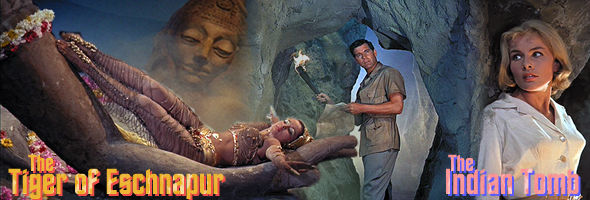 First of all, three very dissimilar quotes: 1) “Every filmmaker, in a sense, defines the essence of cinema, but is there another for whom it is so nakedly, and so unequivocally, as with Lang, the ultimate metaphor?…With Lang, what else can one speak about but a vision of a vision? This does not imply a pointless duplication in which Lang’s art fritters itself away, enmeshed in its own rhythm; on the contrary, it broadens the horizon in all directions, and validates Lang’s answer to the question, ‘What is the most indispensable quality for a filmmaker?’: ‘He must know life.’ Life, here, should be understood as the locus within which vision is exercised. There remains the question of what lies behind this word ‘vision’, exactly what power Lang invests it with, and in what form it appears, tangibly or intangibly.
First of all, three very dissimilar quotes: 1) “Every filmmaker, in a sense, defines the essence of cinema, but is there another for whom it is so nakedly, and so unequivocally, as with Lang, the ultimate metaphor?…With Lang, what else can one speak about but a vision of a vision? This does not imply a pointless duplication in which Lang’s art fritters itself away, enmeshed in its own rhythm; on the contrary, it broadens the horizon in all directions, and validates Lang’s answer to the question, ‘What is the most indispensable quality for a filmmaker?’: ‘He must know life.’ Life, here, should be understood as the locus within which vision is exercised. There remains the question of what lies behind this word ‘vision’, exactly what power Lang invests it with, and in what form it appears, tangibly or intangibly.  Herein lies the explanation for the enthusiasm, inexplicable to some, of certain Lang admirers for his last three films. Filmed in Germany, using a theme and stories from his early period, by a man made master of fiction in all its guises by his American experience, THE TIGER OF ESCHNAPUR, THE INDIAN TOMB and THE 1000 EYES OF DR. MABUSE present the paradox of being at once remarkably veiled and disconcertingly open. Seemingly naive, almost puerile — particularly in the case of the Indian diptych, since a certain grave urgency of theme may be glimpsed beneath the serial conventions and inconsequence of the last MABUSE film — these films, theoretical in the extreme, discard the reassuring alibi of the American tradition while simultaneously transposing the tradition’s basic artificiality to a Germany where nothing has survived: they repudiate the positive aspects of the myths underlying Lang’s German period, reducing them to their own level within a dual adventure, individual and collective, involving the cinema and historical awareness. With exceptional integrity, this destructive-reflective irony of Lang’s toys with the hackneyed stories placed at his disposal, seemingly in derisory fidelity to himself…As for the two Indian films, dazzling moments flitting through precariousness, they tell only of a fine and judicious persistence in which despair surfaces, in which the mise en scène, and even the very idea of mise en scène, looms, as Blanchot said of writing, in the silence that envelops it, a sundering of the elements which compose it, an inability to lie carried to the point of tragedy.” — Raymond Bellour, 1966
Herein lies the explanation for the enthusiasm, inexplicable to some, of certain Lang admirers for his last three films. Filmed in Germany, using a theme and stories from his early period, by a man made master of fiction in all its guises by his American experience, THE TIGER OF ESCHNAPUR, THE INDIAN TOMB and THE 1000 EYES OF DR. MABUSE present the paradox of being at once remarkably veiled and disconcertingly open. Seemingly naive, almost puerile — particularly in the case of the Indian diptych, since a certain grave urgency of theme may be glimpsed beneath the serial conventions and inconsequence of the last MABUSE film — these films, theoretical in the extreme, discard the reassuring alibi of the American tradition while simultaneously transposing the tradition’s basic artificiality to a Germany where nothing has survived: they repudiate the positive aspects of the myths underlying Lang’s German period, reducing them to their own level within a dual adventure, individual and collective, involving the cinema and historical awareness. With exceptional integrity, this destructive-reflective irony of Lang’s toys with the hackneyed stories placed at his disposal, seemingly in derisory fidelity to himself…As for the two Indian films, dazzling moments flitting through precariousness, they tell only of a fine and judicious persistence in which despair surfaces, in which the mise en scène, and even the very idea of mise en scène, looms, as Blanchot said of writing, in the silence that envelops it, a sundering of the elements which compose it, an inability to lie carried to the point of tragedy.” — Raymond Bellour, 1966  2) “Fritz Lang has a morality of iron, one feels that in each of his shots and his camera placements, but one also feels that in his relations with his producers; he’s the only one who succeeds in making a super-production that isn’t a super-product. DER TIGER VON ESCHNAPUR and DAS INDISCHE GRASMAL are the only films that are super-productions without being super-products, which are made with all the money that he had at his disposal without creating a smokescreen. And which nevertheless are not made against money; because now, that’s easier to do: Godard, in his evolution, has discovered that it is necessary to make oppositional films. But for a man of Fritz Lang’s generation, this wasn’t possible, an idea like that. And yet he succeeded in making these two films, where he really gave something to the Germans who had been dying of hunger for so many years — since ‘33 and even before ‘33, up to the Wahrungs-Reform for which the leftist intellectuals had so much contempt, until the moment when the people would begin again to be able to know a little what it meant to live: this is what has been called the German economic miracle. For a good many people, this was the first time that they finally revived, that they were eating normally — of course there was the speculation and all the rest, okay. (The arrival of the consumer society, that’s the negative aspect of it.) But Fritz Lang, at this moment, made something for the people that was a gift, let’s say, of gold. Without it being a golden calf. That’s the important thing. Anyone else would have made a golden calf. The producer was really eager to make a golden calf. Fritz Lang made a film.” — Jean-Marie Straub, 1970
2) “Fritz Lang has a morality of iron, one feels that in each of his shots and his camera placements, but one also feels that in his relations with his producers; he’s the only one who succeeds in making a super-production that isn’t a super-product. DER TIGER VON ESCHNAPUR and DAS INDISCHE GRASMAL are the only films that are super-productions without being super-products, which are made with all the money that he had at his disposal without creating a smokescreen. And which nevertheless are not made against money; because now, that’s easier to do: Godard, in his evolution, has discovered that it is necessary to make oppositional films. But for a man of Fritz Lang’s generation, this wasn’t possible, an idea like that. And yet he succeeded in making these two films, where he really gave something to the Germans who had been dying of hunger for so many years — since ‘33 and even before ‘33, up to the Wahrungs-Reform for which the leftist intellectuals had so much contempt, until the moment when the people would begin again to be able to know a little what it meant to live: this is what has been called the German economic miracle. For a good many people, this was the first time that they finally revived, that they were eating normally — of course there was the speculation and all the rest, okay. (The arrival of the consumer society, that’s the negative aspect of it.) But Fritz Lang, at this moment, made something for the people that was a gift, let’s say, of gold. Without it being a golden calf. That’s the important thing. Anyone else would have made a golden calf. The producer was really eager to make a golden calf. Fritz Lang made a film.” — Jean-Marie Straub, 1970 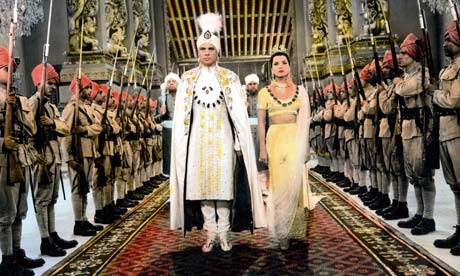 3) “If you respect the Fritz Lang who made M and YOU ONLY LIVE ONCE, if you enjoy the excesses of style and the magnificent absurdities of a film like METROPOLIS, then it is only good sense to reject the ugly stupidity of JOURNEY TO THE LOST CITY. It is an insult to an artist to praise his bad work along with his good; it indicates that you are incapable of judging either.” — Pauline Kael, 1963
3) “If you respect the Fritz Lang who made M and YOU ONLY LIVE ONCE, if you enjoy the excesses of style and the magnificent absurdities of a film like METROPOLIS, then it is only good sense to reject the ugly stupidity of JOURNEY TO THE LOST CITY. It is an insult to an artist to praise his bad work along with his good; it indicates that you are incapable of judging either.” — Pauline Kael, 1963 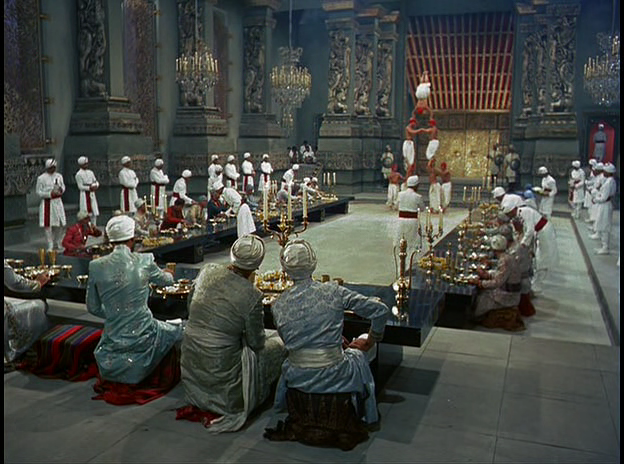 Why has it taken almost a quarter of a century for Fritz Lang’s penultimate films to open in the U.S. in their original form? A key work (albeit an off-key one) by a great director, Lang’s Indian diptych confounds most critical categories by playing both ends against the middle — yielding a deliberately “unsophisticated” film by one of the most sophisticated of all filmmakers, and one made without the slightest trace of condescension for its audience. Created for children and undiscriminating adults, DER TIGER VON ESCHANPUR and DAS INDISCHE GRABNAL has succeeded in Europe with both popular audiences and an intellectual minority — and languished in obscurity, to the best of my knowledge, everywhere else. (In the U.S. and England, it has previously shown only in a dubbed, mutilated and re-edited version known respectively as JOURNEY TO THE LOST CITY and TIGER OF BENGAL, 95 minutes long — which is less that half the length of the 198 minute original.) In the distances formed between the three critical statements cited above, particularly between the first two and the third, a cultural gap of a good deal more than just twenty-odd years and the Atlantic Ocean can be felt. If we are to understand the passion for conceptualism and abstraction in Bellour’s appreciation, the moral and national-historical fervor of Straub’s testimony, and the no less characteristic mistrust of or disinterest in these qualities in Kael’s curt dismissal — it becomes necessary to see these films in all their contradictory uniqueness and paradoxical magnificence, without oversimplifying the case made by any of these three positions.
Why has it taken almost a quarter of a century for Fritz Lang’s penultimate films to open in the U.S. in their original form? A key work (albeit an off-key one) by a great director, Lang’s Indian diptych confounds most critical categories by playing both ends against the middle — yielding a deliberately “unsophisticated” film by one of the most sophisticated of all filmmakers, and one made without the slightest trace of condescension for its audience. Created for children and undiscriminating adults, DER TIGER VON ESCHANPUR and DAS INDISCHE GRABNAL has succeeded in Europe with both popular audiences and an intellectual minority — and languished in obscurity, to the best of my knowledge, everywhere else. (In the U.S. and England, it has previously shown only in a dubbed, mutilated and re-edited version known respectively as JOURNEY TO THE LOST CITY and TIGER OF BENGAL, 95 minutes long — which is less that half the length of the 198 minute original.) In the distances formed between the three critical statements cited above, particularly between the first two and the third, a cultural gap of a good deal more than just twenty-odd years and the Atlantic Ocean can be felt. If we are to understand the passion for conceptualism and abstraction in Bellour’s appreciation, the moral and national-historical fervor of Straub’s testimony, and the no less characteristic mistrust of or disinterest in these qualities in Kael’s curt dismissal — it becomes necessary to see these films in all their contradictory uniqueness and paradoxical magnificence, without oversimplifying the case made by any of these three positions.  In support of Kael’s verdict, it might be noted that Lang himself expressed ambivalence towards his Indian films. [2012 footnote: The late David Overbey, a friend of Lang’s in his late years –- and, I should add, a programmer at the Toronto Festival of Festivals, where I first presented this double-feature in a “Buried Treasures” program, which led directly to Karen Cooper booking it for Film Forum-– told me that Lang would routinely refer to these films as “that Indian shit”.] And we must acknowledge that the films abound with the sort of unpolished artifice that we associate with Grade-Z serials: an Indian princess (Debra Paget) dressed in snazzy Folies-Bergères outfits; a fake cobra moved about with less-than-invisible wires; a glimpsed human frame operating a tiger suit; lepers who come straight from central casting; an implausible plot kept moving by divine intervention and obscure psychological motivations. On the other hand, it should be stressed that (a) despite Kael’s qualms about insulting artists, she is all too willing to settle here for a grotesque travesty version of the film that Lang himself categorically disowned, and (b) whatever the amusement potential of Lang’s pasteboard melodramatics, the films do not qualify as camp in the manner of, say, COBRA WOMAN or GLEN OR GLENDA?, where the sheer unshakable conviction of Maria Montez in the former and Edward D. Wood Jr. in the latter becomes the source of hilarity. On the contrary, apart from the crudeness of a few special effects, the Indian films project a naïveté that is anything but inadvertent — a knowing naïveté that needs to be recognized and discussed as such, on its own terms.
In support of Kael’s verdict, it might be noted that Lang himself expressed ambivalence towards his Indian films. [2012 footnote: The late David Overbey, a friend of Lang’s in his late years –- and, I should add, a programmer at the Toronto Festival of Festivals, where I first presented this double-feature in a “Buried Treasures” program, which led directly to Karen Cooper booking it for Film Forum-– told me that Lang would routinely refer to these films as “that Indian shit”.] And we must acknowledge that the films abound with the sort of unpolished artifice that we associate with Grade-Z serials: an Indian princess (Debra Paget) dressed in snazzy Folies-Bergères outfits; a fake cobra moved about with less-than-invisible wires; a glimpsed human frame operating a tiger suit; lepers who come straight from central casting; an implausible plot kept moving by divine intervention and obscure psychological motivations. On the other hand, it should be stressed that (a) despite Kael’s qualms about insulting artists, she is all too willing to settle here for a grotesque travesty version of the film that Lang himself categorically disowned, and (b) whatever the amusement potential of Lang’s pasteboard melodramatics, the films do not qualify as camp in the manner of, say, COBRA WOMAN or GLEN OR GLENDA?, where the sheer unshakable conviction of Maria Montez in the former and Edward D. Wood Jr. in the latter becomes the source of hilarity. On the contrary, apart from the crudeness of a few special effects, the Indian films project a naïveté that is anything but inadvertent — a knowing naïveté that needs to be recognized and discussed as such, on its own terms. 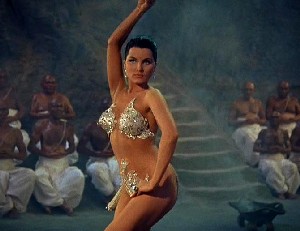 A few words about the films’ origins: After shooting his last American film, BEYOND A REASONABLE DOUBT, in 1956, Lang travelled to India with the hopes of making a film called TAJ-MAHAL, which foundered over casting problems (spurred, according to Lang, by the different ideals of beauty in the West and the East). A couple of years later, he received an offer from a German producer to remake a film which he and Thea von Harbou had scripted and prepared in 1920 for producer-director Joe May — a film which Lang had intended to direct himself, but which was directed instead by May. Agreeing to adapt his original script, Lang returned to Germany and worked on what was almost certainly his most lavish production since the 1927 METROPOLIS — shot over 89 days, 27 of them in India (modest, perhaps, next to the 310 days and 60 nights of shooting on METROPOLIS, but unquestionably a luxury after his two decades in Hollywood).
A few words about the films’ origins: After shooting his last American film, BEYOND A REASONABLE DOUBT, in 1956, Lang travelled to India with the hopes of making a film called TAJ-MAHAL, which foundered over casting problems (spurred, according to Lang, by the different ideals of beauty in the West and the East). A couple of years later, he received an offer from a German producer to remake a film which he and Thea von Harbou had scripted and prepared in 1920 for producer-director Joe May — a film which Lang had intended to direct himself, but which was directed instead by May. Agreeing to adapt his original script, Lang returned to Germany and worked on what was almost certainly his most lavish production since the 1927 METROPOLIS — shot over 89 days, 27 of them in India (modest, perhaps, next to the 310 days and 60 nights of shooting on METROPOLIS, but unquestionably a luxury after his two decades in Hollywood). 
 Committed to pleasure in a way that BEYOND A REASONABLE DOUBT and THE 1000 EYES OF DR. MABUSE clearly are not, THE TIGER OF ESCHNAPUR and THE INDIAN TOMB thus hark back to the origins of Lang’s career — or at least the earliest part of that career that we still have access to, the 1919-20 two-part DIE SPINNEN (THE SPIDERs), shown at Film Forum four years ago. In order to pursue this pleasure, we and Lang alike have to submit to a willfu1 second childhood, a reinvention of the magic of the “fever dream” and the endless serial. And if Lang’s subsequent 1000 EYES is morosely post-TV, his Indian films are triumphant pre-TV in form as well as substance. The difference between RAIDERS OF THE LOST ARK and the Indian films is the difference between engineering and architecture (and it is important to recall that Lang, the only son of an architect, originally planned to follow in his father’s footsteps), Spielberg/Lucas construct an engine to get us as efficiently as possible, in bite-size TV units, to nowhere in particular, shedding images like petals en route. Lang, more interested (like his villains) in foundations that last — images and ideas alike — builds a temple (or tomb) around these ancient supports. Working in a genre that he all but invented himself half a century earlier, he allows his rage for design to fester in every shot — whether it’s getting his hero to smash together two red-turbaned heads, comic-book style, in the opening sequence, dressing his heroine in polka dots, or filling his geometrical décors wi.th other obsessively repetitive patterns. The result is a kind of dream architecture, a pulp India where all the characters become lost in one another’s obsessions.
Committed to pleasure in a way that BEYOND A REASONABLE DOUBT and THE 1000 EYES OF DR. MABUSE clearly are not, THE TIGER OF ESCHNAPUR and THE INDIAN TOMB thus hark back to the origins of Lang’s career — or at least the earliest part of that career that we still have access to, the 1919-20 two-part DIE SPINNEN (THE SPIDERs), shown at Film Forum four years ago. In order to pursue this pleasure, we and Lang alike have to submit to a willfu1 second childhood, a reinvention of the magic of the “fever dream” and the endless serial. And if Lang’s subsequent 1000 EYES is morosely post-TV, his Indian films are triumphant pre-TV in form as well as substance. The difference between RAIDERS OF THE LOST ARK and the Indian films is the difference between engineering and architecture (and it is important to recall that Lang, the only son of an architect, originally planned to follow in his father’s footsteps), Spielberg/Lucas construct an engine to get us as efficiently as possible, in bite-size TV units, to nowhere in particular, shedding images like petals en route. Lang, more interested (like his villains) in foundations that last — images and ideas alike — builds a temple (or tomb) around these ancient supports. Working in a genre that he all but invented himself half a century earlier, he allows his rage for design to fester in every shot — whether it’s getting his hero to smash together two red-turbaned heads, comic-book style, in the opening sequence, dressing his heroine in polka dots, or filling his geometrical décors wi.th other obsessively repetitive patterns. The result is a kind of dream architecture, a pulp India where all the characters become lost in one another’s obsessions. 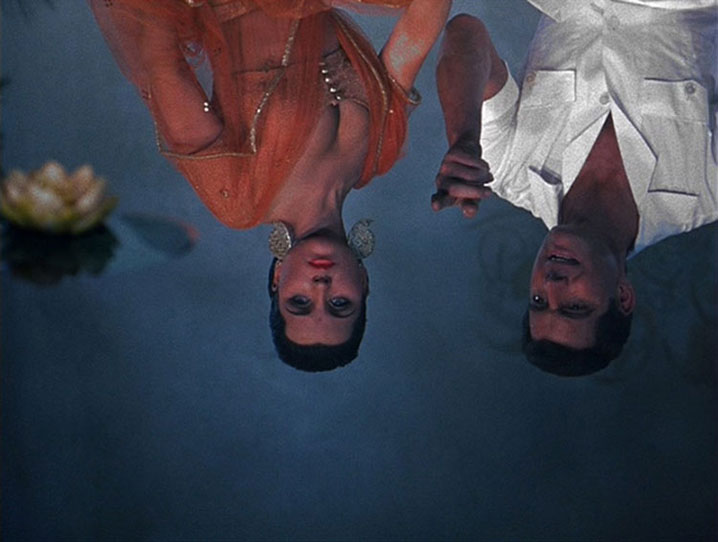 Lang’s last German films are obsessed with representation (reflections in pools, one-way mirrors, TV monitors) and the communication and non-communication existing between cells in a vast human beehive, comprising the outer limits of a bleak moral universe. (Even the spider’s web in THE INDIAN TOMB, an instance of divine intervention, seems to reproduce this pattern in miniature.) In THE 1000 EYES, this universe becomes a nightmare organization of total surveillance. In the sunnier Indian films, it is mainly split between fairy-tale simplicities above ground and social/aesthetic abstractions underground (a tribe of repressed lepers, printed arrows, and a labyrinth of crumbling narrative and architectural foundations which become atomized and disassociated from one another, without the unifying gaze of a Mabuse) — an odd truce between innocence and apocalypse, between the birth and death of storytelling. Spectators who can’t respond comfortably to the more contemporary cardboard décors of HAMMETT and QUERELLE — perhaps because they need to be anchored by pseudo-realistic settings – aren’t likely to feel any better inside Fritz Lang’s head twenty-odd years ago. But those who choose to linger for awhile (“What is an hour in the history of the universe? We have plenty of time…”) and listen to Lang’s 1001 Nights may possibly wind up suspecting that his subterranean caverns comprise the only cave in movies worthy of Plato’s. — Jonathan Rosenbaum, 1983
Lang’s last German films are obsessed with representation (reflections in pools, one-way mirrors, TV monitors) and the communication and non-communication existing between cells in a vast human beehive, comprising the outer limits of a bleak moral universe. (Even the spider’s web in THE INDIAN TOMB, an instance of divine intervention, seems to reproduce this pattern in miniature.) In THE 1000 EYES, this universe becomes a nightmare organization of total surveillance. In the sunnier Indian films, it is mainly split between fairy-tale simplicities above ground and social/aesthetic abstractions underground (a tribe of repressed lepers, printed arrows, and a labyrinth of crumbling narrative and architectural foundations which become atomized and disassociated from one another, without the unifying gaze of a Mabuse) — an odd truce between innocence and apocalypse, between the birth and death of storytelling. Spectators who can’t respond comfortably to the more contemporary cardboard décors of HAMMETT and QUERELLE — perhaps because they need to be anchored by pseudo-realistic settings – aren’t likely to feel any better inside Fritz Lang’s head twenty-odd years ago. But those who choose to linger for awhile (“What is an hour in the history of the universe? We have plenty of time…”) and listen to Lang’s 1001 Nights may possibly wind up suspecting that his subterranean caverns comprise the only cave in movies worthy of Plato’s. — Jonathan Rosenbaum, 1983
* Title under which TIGER OF ESCHNAPUR was released in 1960 in a truncated, dubbed version.
Jonathan Rosenbaum is the author of Moving Places: A Life At The Movies and co-author with J. Hoberman of Midnight Movies. His forthcoming Film: The Front Line 1983 will be published next month. He is currently teaching film at the University of California in Santa Barbara.

